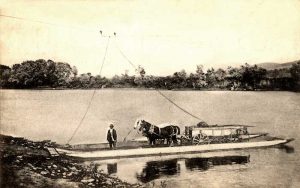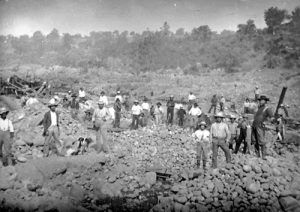By Anthony Belli
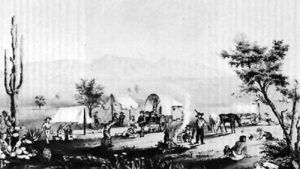
Wagon Train to California
“We were in the domain of the dreaded Indian, with rivers to ford and deserts to cross before we would reach civilization again. Cholera was claiming its victims on the trail before us, but the lure of gold urged us on. “
— California Bound Pioneer
Following James Marshall’s discovery of gold at Sutter’s Mill in January 1848, more than 80,000 men would set off for California within the year. More would come from around the globe. By January of 1850, the era of the ’49er had passed within a year. With the Gold Rush at its pinnacle, 1851-52 were halcyon years. But, as some disgruntled miners returned home in the east with little more than nothing in their pockets, settlers from the east were making their way west to California in ’52. Unlike the ’49ers, who were miners, these pioneer settlers came with their families. They were farmers, merchants, and others who saw the opportunity in California.
Among those first wagon trains to head out to California was a family from Galena, Illinois. Miss Pauline Wonderly was just 15 and recorded her family’s perilous journey into the frontier. Her passage is a real-life saga of life and death. It is a story of survival, murder, massacre, and disease. But it is also a story of births, simple pleasures, and new beginnings.
Pulling out of Galena on April 15, 1852, Pauline’s outfit consisted of four men, her father, uncle, and two others. Her mother and both brothers, one eight the other two. They left in two light wagons with four yokes of oxen and two cows. It was “Hangtown or Bust!” As there was little room in the wagons, it was decided that Pauline would walk, which is exactly what she did, except at streams and rivers.
After crossing the Mississippi River by ferryboat into Iowa, the outfit was mired in snow, nearly making the road impassable. Creeks and rivers were swollen and rising, making fording impossible. The wagons were broken down and floated with passengers and belongings across the raging waters by a heavy rope. Miss Wonderly wrote: “We sat in the wagon bed, very much relieved when we reached the other side.”
One month out of Galena on May 12, the small pioneering party arrived at Council Bluffs, and Pauline noted: “This Mormon settlement was the last civilized place we were to pass through.”
Ten days out of Kanesville, Pauline’s outfit arrived at the scene of the Elk Horn Crossing Massacre. “They [Indians] were burying their dead when we arrived. We were very much frightened for fear they would take vengeance on us, but they retaliated by burning the bridge,” she wrote.
Note: The Elk Horn Crossing Massacre was carried out by whites in an earlier train who refused to pay the Indians a reasonable toll of 25 cents per wagon to cross the Indian-built bridge. Eleven Indians were murdered.
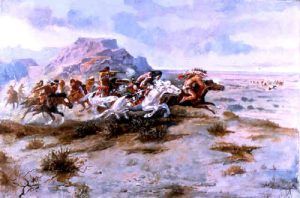
Indian Attack
Fearing an Indian attack, several small outfits were joining larger trains. Pauline’s family joined Captain Meeker’s train and another party, the Bundy family, with eight children bound for Oregon. The Bundys remained with the train until they thought it safe to go ahead as they had horses and could move much quicker. Within days, the Bundys were dying off from cholera; first to go was Mr. Bundy, followed by his eldest and youngest daughters, all laid to rest along the trail. Heartbroken, Mrs. Bundy continued alone with her remaining children for the Oregon frontier.
Traveling through Nebraska on June 7, Pauline’s Mother gave birth to a baby girl. The family pulled out of the train long enough for the birth but soon rejoined the group. Along the trail, they passed by an encampment of men, many dying of cholera, passing through Devil’s Gate, Wyoming, on June 30.
Pauline took over the cooking and laundry with a newborn in her mother’s charge. Misfortune carried off one wagon and kitchen utensils down the swollen crossing at Green River, but with the load lightened, they arrived at Soda Springs on July 18. The following day they left the Oregon Trail behind and took the branch for California, reaching Goose Creek, Nevada, on the 30th.
From August 5 through the 24th, the small caravan would cross and re-cross the Humboldt River a total of 13 times. With spirits at their lowest, provisions nearly gone, animals exhausted, and their wagon ready to fall apart, the party faced the desert. It was the last 26 miles before they pulled into Rag Town [Carson City] that Pauline mentions in her journal: “The whole length of the trail was marked by abandoned wagons, bodies of animals, especially of horses, furniture, cooking utensils, in fact, whole outfits. Graves also dotted the way.”
At Rag Town, the family sold their cattle and bought provisions, arriving in Hot Springs [Genoa] on August 30. They began their ascent over the Sierras on September 2; several in the party split at the Ringgold Trail, leaving only two outfits from the original wagon train, the Wonderly and Unger party, who continued to Hangtown, arriving on the evening of September 10.
Pauline recalls seeing her first Chinaman and settling in Diamond Springs. Later she would be reunited with the Schneider family, who had taken the Ringgold cut-off on September 2. They were operating a hotel at Ringgold. In time her family would settle at Missouri Flat. During her early years in El Dorado County, she witnessed the fires of 1856, which devastated Placerville and Diamond Springs. She also mentions the tragic murder of Susan Newham by Jeremiah Crane and the Ringgold lynch mob that sought justice. But that’s another story.
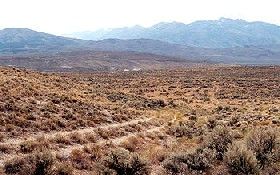
California Trail Ruts
By Anthony Belli © 2004, edited and updated December 2022.
Source: Wonderly, Pauline, Reminiscences of a Pioneer (Placerville, Ca., El Dorado County Historical Society, 1965) edited by John Barton Hassler. About the Author: Anthony M. Belli is a native of California currently living in the Sierras of El Dorado County. Having a background in law enforcement, he was the youngest police chief in Oregon history. Now, Belli is a recognized historian, writer, and lecturer on the California Gold Rush and serves on the research staff for the El Dorado County Museum. He has been featured in several television programs, writes for Lost Treasure Magazine, wrote Mysteries of Tahoe – Lost Treasure, and is currently working on a second book.
Also See:
The California Trail – Rush to Gold

